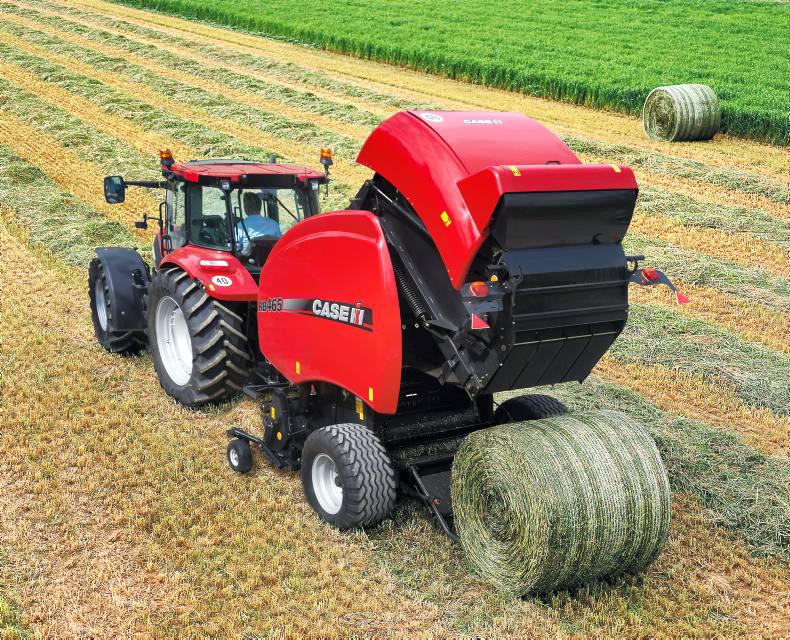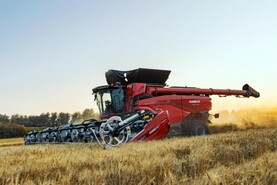According to Sean Byrne from Case IH, the new range of balers from the company will suit most farmers and contractors, offering the choice of both fixed and variable-chamber design. The Case RB Silage-Pack now offers the option of film-wrapped bales.
The RB 344 fixed chamber baler
The RB baler range features a 2m-wide pickup, with close tine spacing and height control. The crop is then passed to the 1.4m-wide rotary feeder or cutter, which is 20cm wider than the bale chamber, to give high-quality bales with compact, firm edges, according to Sean. An optional front-mounted wind guard roller kit improves field performance in high-volume silage and hay crops.
Fixed chamber models
RB 344 rotor/feeder – 2m pick-up, for the larger farmer and contractor harvesting mainly silage, requiring twine or net wrapping.
RB 344 Silage-pack – rotor/cutter version with net wrapping and 2m pickup, for the larger farmer and contractor requiring film-wrapped bales with low labour input.
Designed as an integral part of the baling system, the 1.4m-wide rotor/cutter features a quick change selection system, allowing easy changing between three, seven or 15 knives. These electrically controlled knives produce high-density nutritious bales for easy distribution, according to Case.
Blanking plates can be inserted in place of the knives should they be required. Case IH says with the rotor cutter, up to a 20% increase in density can be achieved.
The bale chamber incorporates a fully enclosed roller chain and elevator system that uses 34 heavy duty steel bars to firmly grip the bale as it forms. As the bale grows in size and density, the rotation bars become embedded in the bale’s outer surface, giving a positive grip to turn the bale without slipping or jamming.
This positive rotation at the early forming stage makes it easier to roll out each bale almost to its centre.
Electronic density control
To produce the ideal bale, density is controlled by two strong springs. After the core is formed and the bale starts to grow, two electronic monitoring devices – mounted between the tailgate and the baler frame – monitor pressure in the bale chamber. The required density level is pre-set on the performance monitor and when this preset level is reached, the wrapping process will automatically start after giving the operator a warning signal. This simple and efficient control system allows the operator to make precise density adjustments to suit the crop conditions.
The RB 455/65 Variable belt baler
Case IH believes the variable chamber is perfect for customers who need a flexible bale size to suit their crop and storage conditions. Four individual rollers form part of the bale chamber design, forming a small chamber to start early crop rotation. The RB design allows for relatively short belts to be used in conjunction with the formation rollers. Case says that four high-strength laced endless belts produce perfectly formed high-density bales, with outstanding weathering characteristics. The belt surface grips and rotates the bale as it forms without slipping or jamming, producing a tightly packed, well-formed bale with a weather-resistant surface.
Two of the lower tailgate rollers are adjustable for continued high performance of the belts. To produce the ideal core, belt tension and core density are controlled by coil springs. As soon as the core is formed and the bale starts to grow, the belt tension and density are increased dramatically. The position of the belt tension arm is controlled by a powerful hydraulic ram. For exceptional high-density requirements, a second optional hydraulic density cylinder can be added. An easy-to-adjust density control valve allows the operator to make precise and accurate adjustments to suit crop conditions and customer bale density requirements. During operation, a pressure indicator gauge can be viewed from the cab.
Case IH Cranes Farm Road, Basildon, Essex, SS15 4AD, UK
Email: sean.byrne@caseih.com
To read the full Grass and Muck Magazine click here.






 This is a subscriber-only article
This is a subscriber-only article










SHARING OPTIONS: